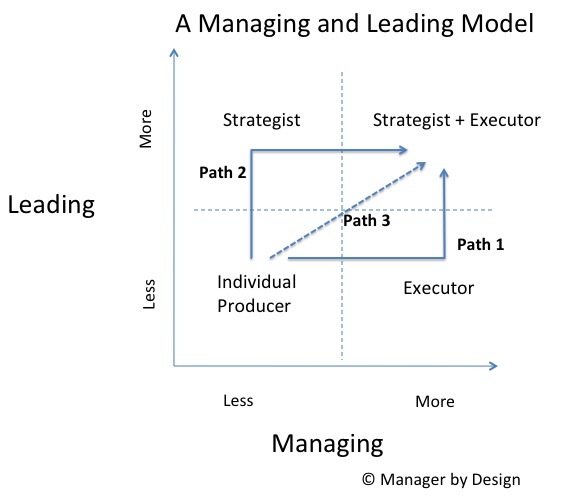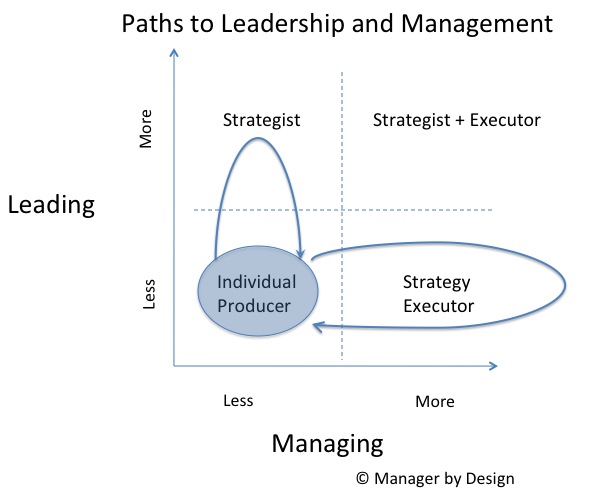Management Design: An alternative path to management and leadership: Loop in and out
When looking at the Manager by Designsm leadership and management model, we can see some opportunities for better management design. Using the model in my previous article, I note that there are three common paths for creating managers and leaders (the two concepts often get conflated – the model attempts to differentiate). Here are the three paths:
What I find interesting about this view is that, according to this model, the paths all conclude with the individual being both a strategist and a strategy executor. In short, the paths imply the person has two jobs: Coming up with the ideas and seeing the ideas through.
These appear to be two entirely different skill sets, and skill sets that should be valued separately. There are certainly some people who can do both strategy and strategy execution well, but, really, how many? And do people who like to strategize also like to manage a team? Maybe sometimes, but not always.
So it would be important to find out, wouldn’t it? Let’s say you have someone in your organization who is very good at strategy. That sounds like something that would be valuable to many organizations. How do you find out? Does that population come from the “Strategy Executor” group? Or would it come from the individual producer group?
And once that strategist is identified, is it a full time job? Or do you make it one by transforming the strategist into a strategist + strategy executor?
In the current management design, the most common action is to look for the strategists from the management group (strategy executor group) (path 1 or 2 above).
There are a few of problems with this “design” (or perhaps an accidental by-product of ingrained organizational habits):
- This seems to limit the population of possible strategists as coming from strategy executors
- It sublimates the act of team management by devaluing excellence in team management
- Setting strategy is a part-time job, being shared with strategy executor.
In looking at path 3, it assumes that strategy is a springboard to management, and that the skill of setting strategy isn’t “enough” of leadership, and requires immediately halving this role to include managing a team.
So all of these “designs” appear to have inherent risks, which includes asking a leader to lead in a way that they aren’t good at, and asking a manager to become a leader/strategist.
So what are alternate paths? Here are a few that would seem less risky to me, and allow people and organizations to see what they are good at.
In this design, you have a means for people to hone their skills in what can be considered two different skill sets – strategy and strategy execution. In doing this, they can focus on the aspect of what they are being asked to do without the clutter of conflating leadership and management.
They can also practice these skill sets without committing to them, and can return to their individual producer role, and explore other aspects of “leadership” or “management”, knowing what they are expected to do to perform in these roles. The design allows for multiple people to “oscillate” in and out of management and leadership roles. Or draw from a pool of people who are confirmed able to perform a leadership/management role, thus reducing risk and waste in the strategy-setting process or the strategy execution process.
Once someone has demonstrated this ability in both leadership and management, they can then do the “advanced” move of being both a strategist and strategy executor at the same time. This design doesn’t require this graduation to the “advanced move” and instead allows for “leadership” and “management” to be performed by those whose strengths are in the appropriate areas.
This isn’t a design that all organizations should follow, but perhaps it is one to experiment with and consider. It’s not that the existing “designs” are that stellar! (See the cost of low quality management).
Does your organization have the ability identify those who are good at strategy, and let them develop it, try it and master it? Is this a design you have seen in action? Or does your organization have the typical design of asking a promoted individual to try to be both a manager and a leader and risk being bad at both?
A model to show the difference between managing and leading
Management Design: The Designs we have now: The paths to management and leadership
Management Design: The designs we have now – Manager knows and supports only one possible strategy
Management Design: The Designs we have now: Part time strategist, part time manager
Current management design: The one with the ideas becomes the manager
Tenets of Management Design: Focus on the basics, then move to style points
The Cost of Low Quality Management





Comments
2 Responses to “Management Design: An alternative path to management and leadership: Loop in and out”Trackbacks
Check out what others are saying about this post...[…] […]
[…] Management Design: An alternative path to management and leadership: Loop in and out […]